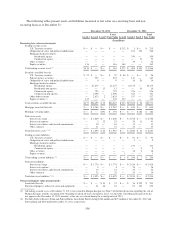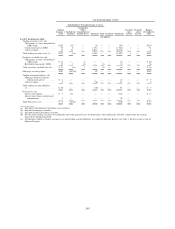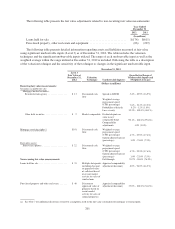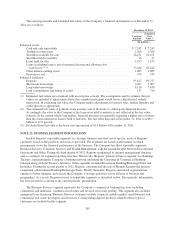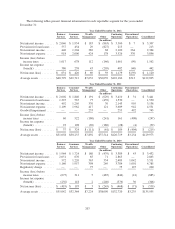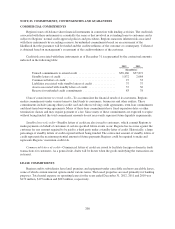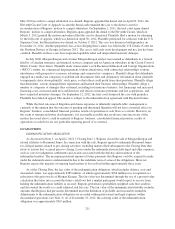Regions Bank 2012 Annual Report Download - page 218
Download and view the complete annual report
Please find page 218 of the 2012 Regions Bank annual report below. You can navigate through the pages in the report by either clicking on the pages listed below, or by using the keyword search tool below to find specific information within the annual report.
RECURRING FAIR VALUE MEASUREMENTS USING SIGNIFICANT UNOBSERVABLE INPUTS
Securities available for sale
Mortgage backed securities: residential non-agency—The fair value reported in this category relates to
retained interests in legacy securitizations. Significant unobservable inputs include the spread to LIBOR,
constant prepayment rate, probability of default, and loss severity in the event of default. Significant increases in
any of these inputs in isolation would result in significantly lower fair value measurement. Generally, a change in
the assumption used for the probability of default is accompanied by a directionally similar change in the
assumption used for loss severity and a directionally opposite change in the assumption used for prepayment
rates.
Other debt securities—Significant unobservable inputs include evaluated quotes on comparable bonds for
the same issuer and management-determined comparability adjustments. Changes in the evaluated quote on
comparable bonds would result in a directionally similar change in the fair value of the other debt securities.
Mortgage Servicing Rights
The significant unobservable inputs used in the fair value measurement of mortgage servicing rights are
option adjusted spreads (“OAS”) and prepayment speed. This method requires generating cash flow projections
over multiple interest rate scenarios and discounting those cash flows at a risk adjusted rate. Additionally, the
impact of prepayments and changes in the option adjusted spread are based on a variety of underlying inputs such
as servicing costs. Increases or decreases to the underlying cash flow inputs will have a corresponding impact on
the value of the mortgage servicing right asset. The net change in unrealized gains (losses) included in earnings
related to mortgage servicing rights held at period end are disclosed as the changes in valuation inputs or
assumptions. See Note 7 for these amounts and additional disclosures related to assumptions used in the fair
value calculation for mortgage servicing rights.
Derivative assets
Interest rate options—These instruments are interest rate lock agreements made in the normal course of
originating residential mortgage loans. Significant unobservable inputs in the fair value measurement are OAS,
prepayment speeds, and pull-through. The impact of OAS and prepayment speed inputs in the valuation of these
derivative instruments are consistent with the MSR discussion above. Pull-through is an estimate of the number
of interest rate lock commitments that will ultimately become funded loans. Increases or decreases in the pull-
through assumption will have a corresponding impact on the value of these derivative assets.
NON-RECURRING FAIR VALUE MEASUREMENTS USING SIGNIFICANT UNOBSERVABLE INPUTS
Loans held for sale
Loans held for sale are valued based on multiple data points indicating the fair value for each loan. The
primary data point for non-performing investor real estate loans is a discount to the appraised value of the
underlying collateral, which considers the return required by potential buyers of the loans. Management
establishes this discount or comparability adjustment based on recent sales of loans secured by similar property
types. As liquidity in the market increases or decreases, the comparability adjustment and the resulting asset
valuation are impacted.
Foreclosed property and other real estate
Foreclosed property and other real estate are valued based on offered quotes as available. If no sales contract
is pending for a specific property, management establishes a comparability adjustment to the appraised value
based on historical activity considering proceeds for properties sold versus the corresponding appraised value.
Increases or decreases in realization for properties sold impact the comparability adjustment for similar assets
remaining on the balance sheet.
202






